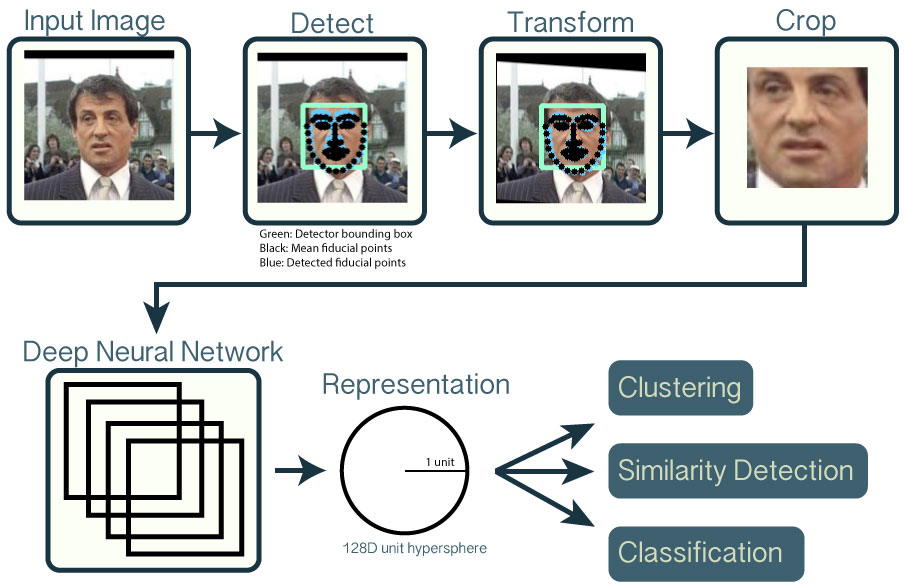https://cmusatyalab.github.io/openface/
OpenFace
News
- 2016-01-19: OpenFace 0.2.0 released! See this blog post for more details.
OpenFace is a Python and Torch implementation of face recognition with deep neural networks and is based on the CVPR 2015 paper FaceNet: A Unified Embedding for Face Recognition and Clustering by Florian Schroff, Dmitry Kalenichenko, and James Philbin at Google. Torch allows the network to be executed on a CPU or with CUDA.
Crafted by Brandon Amos in Satya's research group at Carnegie Mellon University.
- The code is available on GitHub at cmusatyalab/openface.
- API Documentation
- Join the cmu-openface group or the gitter chat for discussions and installation issues.
- Development discussions and bugs reports are on the issue tracker.
This research was supported by the National Science Foundation (NSF) under grant number CNS-1518865. Additional support was provided by the Intel Corporation, Google, Vodafone, NVIDIA, and the Conklin Kistler family fund. Any opinions, findings, conclusions or recommendations expressed in this material are those of the authors and should not be attributed to their employers or funding sources.
Isn't face recognition a solved problem?
No! Accuracies from research papers have just begun to surpass human accuracies on some benchmarks. The accuracies of open source face recognition systems lag behind the state-of-the-art. See our accuracy comparisons on the famous LFW benchmark.
Please use responsibly!
We do not support the use of this project in applications that violate privacy and security. We are using this to help cognitively impaired users sense and understand the world around them.
Overview
The following overview shows the workflow for a single input image of Sylvestor Stallone from the publicly available LFW dataset.
- Detect faces with a pre-trained models from dlib or OpenCV.
- Transform the face for the neural network. This repository uses dlib's real-time pose estimation with OpenCV's affine transformation to try to make the eyes and bottom lip appear in the same location on each image.
- Use a deep neural network to represent (or embed) the face on a 128-dimensional unit hypersphere. The embedding is a generic representation for anybody's face. Unlike other face representations, this embedding has the nice property that a larger distance between two face embeddings means that the faces are likely not of the same person. This property makes clustering, similarity detection, and classification tasks easier than other face recognition techniques where the Euclidean distance between features is not meaningful.
- Apply your favorite clustering or classification techniques to the features to complete your recognition task. See below for our examples for classification and similarity detection, including an online web demo.

News
- [Oct 15, 2015] (Spanish) GenBeta: OpenFace, un nuevo software de reconocimiento facial, de código abierto
- [Oct 15, 2015] TheNextWeb: Watch this open-source program recognize faces in real time
Blogosphere
- [Feb 24, 2016] Hey Zuck, We Built Your Office A.I. Solution
- [Feb 3, 2016] RTNiFiOpenFace and WebSocketServer add face recognition to an Apache NiFi video flow
- [Jan 29, 2016] Integrating OpenFace into an Apache NiFi flow using WebSockets
Projects using OpenFace
- pyannote/pyannote-video: Face detection, tracking, and clustering in videos.
- aybassiouny/OpenFaceCpp: Unofficial C++ implementation.
Citations
The following is a BibTeX and plaintext reference for the OpenFace GitHub repository. The reference may change in the future. The BibTeX entry requires the url LaTeX package.
@misc{amos2016openface,
title = {{OpenFace: Face Recognition with Deep Neural Networks}},
author = {Amos, Brandon and Ludwiczuk, Bartosz and Harkes, Jan and
Pillai, Padmanabhan and Elgazzar, Khalid and Satyanarayanan, Mahadev},
howpublished = {\url{http://github.com/cmusatyalab/openface}},
note = {Accessed: 2016-01-11}
}
Brandon Amos, Bartosz Ludwiczuk, Jan Harkes, Padmanabhan Pillai,
Khalid Elgazzar, and Mahadev Satyanarayanan.
OpenFace: Face Recognition with Deep Neural Networks.
http://github.com/cmusatyalab/openface.
Accessed: 2016-01-11
Acknowledgements
- The fantastic Torch ecosystem and community.
- Alfredo Canziani's implementation of FaceNet's loss function in torch-TripletEmbedding.
- Nicholas Léonard for quickly merging my pull requests to nicholas-leonard/dpnn modifying the inception layer.
- Francisco Massa and Andrej Karpathy for quickly releasing nn.Normalize after I expressed interest in using it.
- Soumith Chintala for help with the fbcunn example code.
- Davis King's dlib library for face detection and alignment.
- The GitHub issue and pull request templates are inspired from Randy Olsen's templates at rhiever/tpot, Justin Abrahms' PR template, and Aurelia Moser's issue template.
- Zhuo Chen, Kiryong Ha, Wenlu Hu, Rahul Sukthankar, and Junjue Wang for insightful discussions.
Licensing
Unless otherwise stated, the source code and trained Torch and Python model files are copyright Carnegie Mellon University and licensed under the Apache 2.0 License. Portions from the following third party sources have been modified and are included in this repository. These portions are noted in the source files and are copyright their respective authors with the licenses listed.
| Project | Modified | License | |
|---|---|---|---|
| Atcold/torch-TripletEmbedding | No | MIT | |
| facebook/fbnn | Yes | BSD |
'Computer Vision' 카테고리의 다른 글
| Iris Recognition Algorithms Comparison between Daugman algorithm and Hough transform on Matlab (0) | 2016.05.11 |
|---|---|
| facerec framework (0) | 2016.05.10 |
| Face recognition with deep neural networks. http://cmusatyalab.github.io/openface/ (0) | 2016.05.09 |
| Facial Feature Tracking with SO-CLM (0) | 2016.05.09 |
| gaze tracker (0) | 2016.05.09 |



